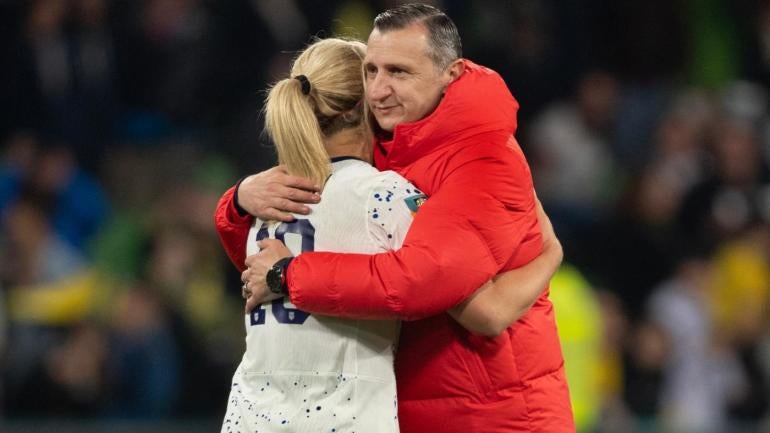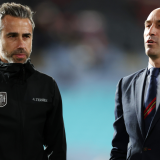
The U.S. women's national team are out of the Women's World Cup following a loss on penalties to Sweden in the round of 16, and after an uneven showing Down Under, there will be plenty of questions to answer as to how they should rebuild.
A rebuild that started after the USWNT's 2019 World Cup victory will likely continue en route to the 2027 tournament, with Megan Rapinoe set to retire and others likely to follow. The program could face more changes, especially with head coach Vlatko Andonvoski's future hanging in the balance following the USWNT's earliest World Cup exit ever.
U.S. Soccer president Cindy Parlow Cone and USWNT general manager Kate Markgraf will have plenty of food for thought from the World Cup alone and an even bigger task ahead of them as a new era of women's soccer begins.
1. Will there be a coaching change?
The USWNT's performance against Sweden was undoubtedly the team's best showing at the World Cup and proved Andonovski's tactical savvy. He switched out of a 4-3-3, in which the team struggled to dominate in midfield, and opted for a 4-2-3-1 that allowed the team to be fluid and productive across the pitch. His overall body of work at the World Cup forces the question, though -- will he be entrusted to oversee the team for another World Cup cycle?

Golazo Starting XI Newsletter
Get your Soccer Fix from Around the Globe
Your ultimate guide to the Beautiful Game as our experts take you beyond the pitch and around the globe with news that matters.
Thanks for signing up!
Keep an eye on your inbox.
Sorry!
There was an error processing your subscription.
Andonovski can claim several wins during his nearly four-year stint as the USWNT coach. He was tasked with integrating young players into the team in time for this tournament and several like Sophia Smith and Naomi Girma proved they have the credentials to go far. Andonovski's USWNT also showed impressive defensive resolve at the World Cup -- they conceded just two shots on target throughout the tournament and might be through to the quarterfinals if not for goalkeeper Zecira Musovic's stellar display.
The head coach, though, arguably did not make a case to stick around during the group stage. The tactical shift that came against Sweden should have come earlier in the tournament, and his team managed to score just four goals in four games and went more than 200 minutes without scoring. It likely means Andonovski's time is up, but U.S. Soccer will have a very quick timeline to replace him should they choose to do so as the Olympic Games are less than a year away.
Craving even more coverage of the FIFA Women's World Cup? Don't miss a beat of the action from Down Under and listen to Attacking Third below for all the latest news, previews, analysis and more!
2. How will the USWNT adapt to the new world order?
This tournament marks the end of an era in many ways, but not just as it pertains to the USWNT's dominance. The quality gap is closing at a rapid pace -- just ask Germany, Brazil, and Canada. The USWNT's knack for winning is no longer a sure thing, and regardless of who is in charge for the next cycle, the federation will need to prioritize keeping pace with the rest of the world as they reevaluate things.
The USWNT coach -- be it Andonovski or a new hire -- will need to demonstrate a tactical prowess that will allow the four-time World Cup winners to beat a crop of rising talent. The initial objective will be to avoid games like the group-stage encounter with Portugal, where the Americans were unable to dominate in midfield and were doomed to a 0-0 draw. U.S. Soccer will also likely search for a return to the team's attacking identity, even in a changing women's soccer landscape.
Not everything is down to the coach, though. The federation will need to ensure that it invests wisely in its youth program after a string of unimpressive results. The youth teams have not made it to a World Cup semifinal since 2016, when the U-20 team finished fourth and has not won a youth World Cup since the 2012 U-20 team that featured Crystal Dunn, Julie Ertz, and Sam Mewis. The onus will also be on stakeholders in CONCACAF and the NWSL to invest in continental and league competitions to ensure American women's soccer stays on pace with Europe, where players benefit from year-round competition.
3. Who's up top?
The World Cup likely served as a last run for a handful of USWNT veterans, and we may see a new-look team right away. The team's major weakness at the World Cup was the attack and no doubt the focus will once again be on the forwards as the USWNT looks to rebuild.
Alex Morgan could be phased out right away after a disappointing World Cup where she did not score a single goal, and Smith seems poised to take her spot immediately. Trinity Rodman also looks like she's a contender for a starting spot, while 18-year-old Alyssa Thompson will probably be slowly integrated into the team over the next four years. The youth revolution that Andonovski started is far from over, though -- the other forwards on the World Cup roster, plus a handful of attacking midfielders, are in their 30s now or will be by the next World Cup.
A simple fix to the USWNT's World Cup attacking issues could just be allowing Smith to succeed Morgan right away. One of the first questions the team will have to answer post-World Cup, though, is how they get back to goalscoring ways -- and who they rely on to do so.






















